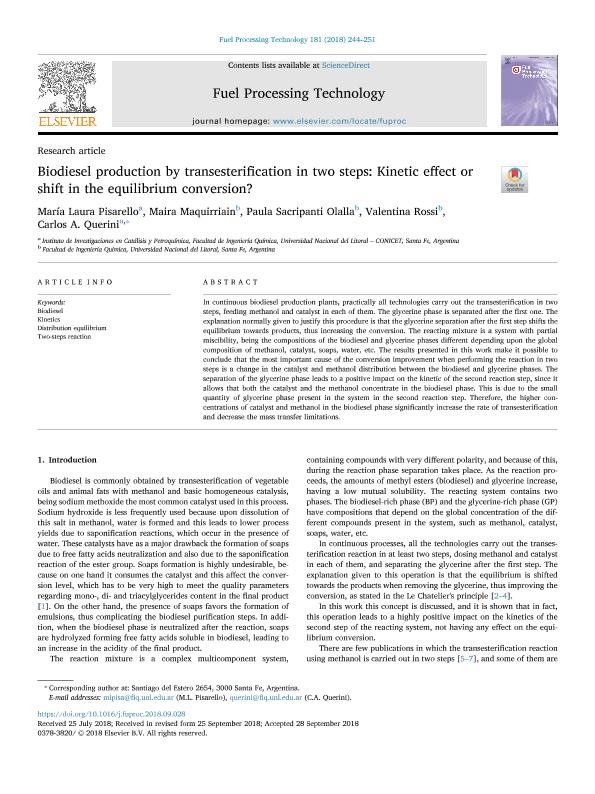Artículo
Biodiesel production by transesterification in two steps: Kinetic effect or shift in the equilibrium conversion?
Pisarello Milesi, Maria Laura ; Maquirriain, Maira Alejandra
; Maquirriain, Maira Alejandra ; Sacripanti Olalla, Paula; Rossi, Valentina; Querini, Carlos Alberto
; Sacripanti Olalla, Paula; Rossi, Valentina; Querini, Carlos Alberto
 ; Maquirriain, Maira Alejandra
; Maquirriain, Maira Alejandra ; Sacripanti Olalla, Paula; Rossi, Valentina; Querini, Carlos Alberto
; Sacripanti Olalla, Paula; Rossi, Valentina; Querini, Carlos Alberto
Fecha de publicación:
12/2018
Editorial:
Elsevier Science
Revista:
Fuel Processing Technology
ISSN:
0378-3820
Idioma:
Inglés
Tipo de recurso:
Artículo publicado
Clasificación temática:
Resumen
In continuous biodiesel production plants, practically all technologies carry out the transesterification in two steps, feeding methanol and catalyst in each of them. The glycerine phase is separated after the first one. The explanation normally given to justify this procedure is that the glycerine separation after the first step shifts the equilibrium towards products, thus increasing the conversion. The reacting mixture is a system with partial miscibility, being the compositions of the biodiesel and glycerine phases different depending upon the global composition of methanol, catalyst, soaps, water, etc. The results presented in this work make it possible to conclude that the most important cause of the conversion improvement when performing the reaction in two steps is a change in the catalyst and methanol distribution between the biodiesel and glycerine phases. The separation of the glycerine phase leads to a positive impact on the kinetic of the second reaction step, since it allows that both the catalyst and the methanol concentrate in the biodiesel phase. This is due to the small quantity of glycerine phase present in the system in the second reaction step. Therefore, the higher concentrations of catalyst and methanol in the biodiesel phase significantly increase the rate of transesterification and decrease the mass transfer limitations.
Palabras clave:
BIODIESEL
,
DISTRIBUTION EQUILIBRIUM
,
KINETICS
,
TWO-STEPS REACTION
Archivos asociados
Licencia
Identificadores
Colecciones
Articulos(INCAPE)
Articulos de INST.DE INVEST.EN CATALISIS Y PETROQUIMICA "ING. JOSE MIGUEL PARERA"
Articulos de INST.DE INVEST.EN CATALISIS Y PETROQUIMICA "ING. JOSE MIGUEL PARERA"
Citación
Pisarello Milesi, Maria Laura; Maquirriain, Maira Alejandra; Sacripanti Olalla, Paula; Rossi, Valentina; Querini, Carlos Alberto; Biodiesel production by transesterification in two steps: Kinetic effect or shift in the equilibrium conversion?; Elsevier Science; Fuel Processing Technology; 181; 12-2018; 244-251
Compartir
Altmétricas



